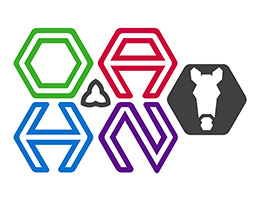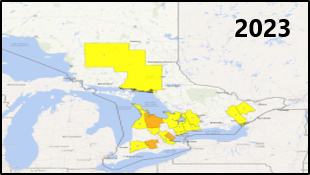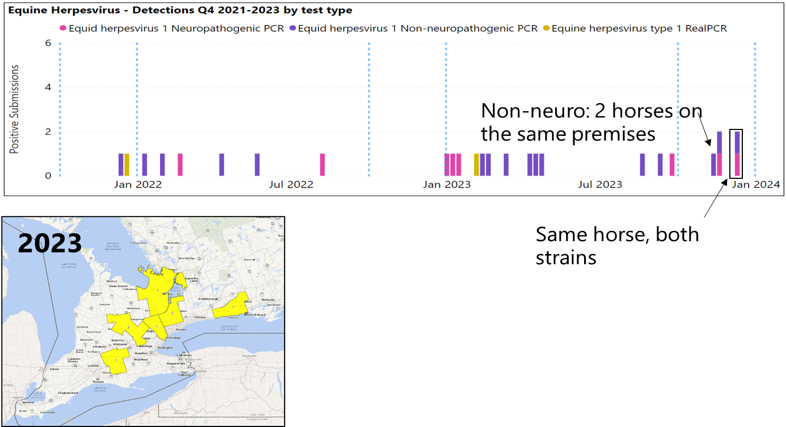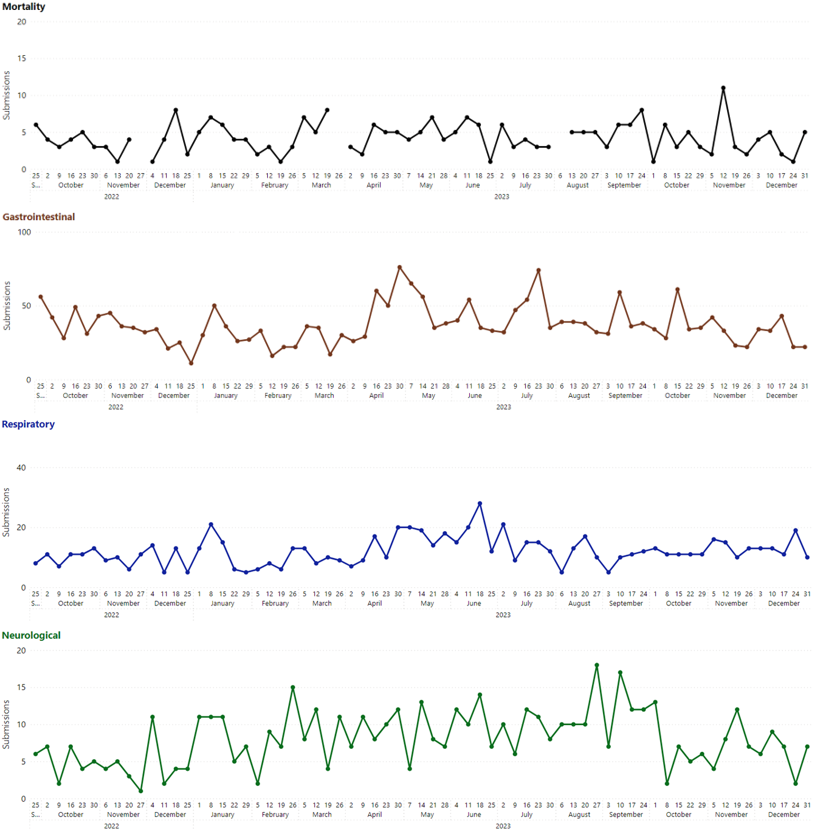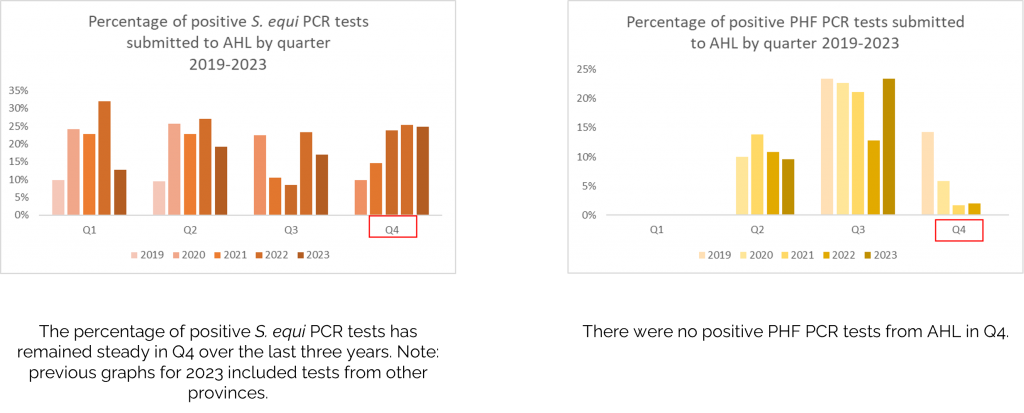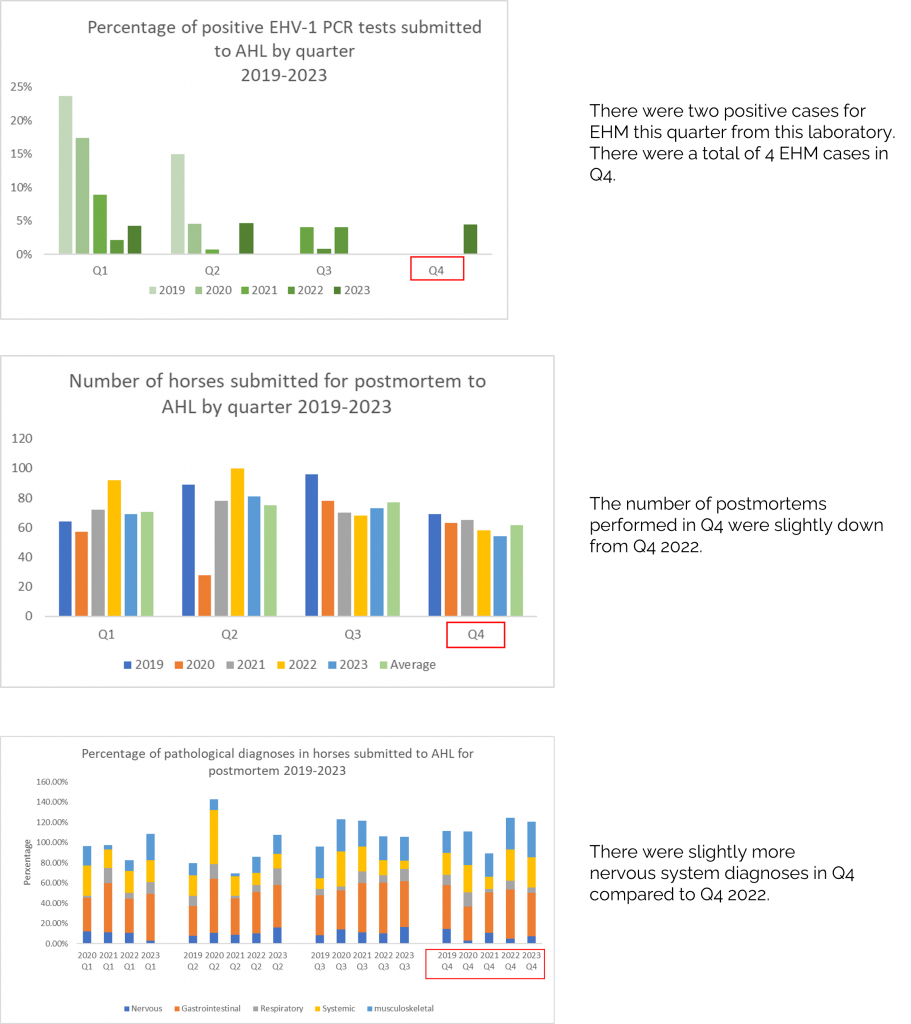Ontario Animal Health Network (OAHN)
Equine Expert Network
Quarterly Veterinary Report
OAHN Equine has a dedicated Instagram and Facebook page!
Help us spread the word to horse owners, industry participants and equine veterinarians!
Strangles and EHV-1 Resources
The OAHN Equine network has put together a list of Strangles and EHV-1 resources for veterinarians and owners. They are available at:
Equine Strangles Resources – Ontario Animal Health Network (oahn.ca) and
Equine Herpesvirus-1 Resources – Ontario Animal Health Network (oahn.ca)
The Ontario map of facilities dealing with Strangles and EHM can be found here:
Equine Disease Tracking Network v 2.1 (arcgis.com)
Strangles and EHM alert notifications are available at:
Ontario Equine Disease Alerts – Ontario Animal Health Network (oahn.ca) or
Outbreaks | Equine Disease Communication Center (equinediseasecc.org
BITS ‘N SNIPS
Large Animal Rescue Training
One of the discussion topics on the network call concerned the occurrence of down geriatric horses in winter. We didn’t land on a cause for this condition, and it certainly could be multifactorial ( e.g. body condition, orthopedic conditions, sleep disorders etc.), but it did lead to a discussion on the use of large animal rescue methods to assist these horses to stand. This type of training is useful for veterinarians in many other situations as well, including; horses that are down in a stall, stuck in a doorway, down in a ditch etc. Equine Guelph hosts this training and offers an Awareness Level Workshop and an Operational Level (certification) Workshop. Follow these links for more details.
Large Animal Rescue Workshop (Awareness Level: Hands on) – 1 Day – The Horse Portal
Large Animal Rescue Workshop (Operational Level: Hands on) – 2 Days – The Horse Portal
Network Member Reports
| Southwestern Region
(Melissa McKee) |
Weather conditions seemed to play a part in disease occurrence over Q4 and into Q1. We saw fewer oxytetracycline responsive diarrheas than in the past but had a bit of colitis as is typical in the fall. As the temperatures dropped, we saw an uptick in impaction colic cases and down older horses. As well, as the barns closed up to keep out the cold, more asthma cases were diagnosed. The wet, warm weather earlier in the quarter brought with it plenty of dermatitis cases, most notable in the standardbred racehorses that had already started to develop a winter coat which kept the skin moist as the temperatures went up and down. We also had an uptick in fall-associated laminitis cases in horses with metabolic disease and a severe case of Lawsonia intracellularis enteritis in a weanling. Strangles cases continued to occur at boarding facilities and we spent time managing horses with persistent infections including chondroids. |
| Western Region
(Tara Foy) |
In Q4 we saw several third trimester abortion/stillbirths but nothing significant was diagnosed. We managed a number of horses with mud fever and cellulitis. After the sales, we had a number of yearlings that were dealing with lower limb edema and low WBC (mainly lymphocytes) on hematology. They did not have fevers or nasal discharge. We referred a case of a fever of unknown origin. The mare had a high fever for several days. No cough or diarrhea developed. It resolved uneventfully and remained idiopathic. |
| Eastern Ontario
(John Donovan) |
Cases of EEE were fewer this quarter. Overall Q4 was pretty uneventful compared to Q3 and we were diagnosing the standard conditions we see in the fall such as fall laminitis, asthma and impaction colics as the weather became colder. We did see a few more surgical colics than was typical . The hay was not the quality we generally like to see and likely contributed to several of the asthma cases. We also examined a number of dermatologic cases. The late fall was quite wet in our area and we had a lot of muddy fields with abscesses and cellulitis secondary to foot hygiene problems. Some of the cellulitis cases were quite challenging and non-responsive to our typical antibiotic therapies. Ocular cases may have been increased in number, especially corneal ulcers and equine recurrent uveitis. Some of the corneal ulcers were severe enough to warrant subpalpebral lavage systems for long term treatment. |
| Ontario Veterinary College
(Memo Arroyo) |
In Q4, we saw a wide variety of cases; colitis cases, neurologic cases (wobblers with mild clinical signs), late pregnancy colics (7 months of gestation +), and a couple of dystocias. We also had our first neonatal foal (early drop) of the season. We also had fewer eye cases referred in but saw a small spike in asthma cases likely due to environmental conditions. We had an unusual case of a left dorsal colon tear with no etiological agent identified to cause the tear (e.g. no foreign body). We also had a couple of necrotizing hemorrhagic pneumonias that presented as enteritis cases. |
| AHL Pathology
(Emily Ratsep) |
|
| OMAFRA
(Hannah Golightly & Alison Moore) |
Immediately Notifiable Diseases: Case Reports to OMAFRA
West Nile Virus (WNV): There were a total of 6 confirmed cases of WNV diagnosed in 2023, with one of these cases diagnosed in Q4 (Oct – Dec 2023).
 Eastern Equine Encephalitis: There were 2 horses diagnosed with eastern equine encephalitis (EEE) in Q4.
*There were no EEE cases reported in 2022. Strangles: During Q4 there were 9 new facilities managing Strangles, making a total of 27 affected facilities in 2023 (since Strangles became immediately reportable to OMAFRA on Feb 1, 2023).
Equine Herpesvirus: There were 3 cases of EHM due to EHV-1 in Q3. There were 4 horses diagnosed with EHM in Q4.
Q4 Equine Syndromic Surveillance: Graphs of disease syndromes based on samples sent for testing to the Animal Health Laboratory. This information is compiled based on the type of sample, test ordered, and key terms included in the submission history (if provided).
|
Please follow:
Outbreaks | Equine Disease Communication Center (equinediseasecc.org) for reported outbreaks!
Syndromic and AHL Laboratory Data Surveillance
Survey – Key points
- 29 Counties represented
- 78% equine, 9% equine and food animal, 9% equine and small animal and 4% referral practice veterinarians responded.
- 23% of veterinarians reported working with Performance/Competition/Show horses, 22% of veterinarians with pleasure/backyard horses, 17% foals, breeding and young stock, 12% racehorses, 11% draft horses, 10% mules/donkeys and 4% buggy horses.
- Increases in Q4 were noted for (foal): Lawsonia intracellularis enteritis, equine degenerative myeloencephalopathy;
- Increases in Q4 were noted for (adult) Equine asthma, Strangles, pneumonia /pleuropneumonia Potomac Horse Fever, EGUS, surgical and non-surgical colics, CVM, dermatitis, ringworm, EMS with laminitis, fluid fecal syndrome, tendon/ligament injuries, spinal injuries, exertional rhabdomyolysis, anaplasmosis, bacterial cholangiohepatitis, fungal endometritis, sarcoids, EHV-2 and 5.
New conditions or those without a diagnosis:
- Acute kidney injury in a weanling WB colt – negative on acute and convalescent leptospirosis titers
- Ventral abdomen edema of unknown cause
- ADR off feed young track horses – significant transient neutropenia. Seemed to end with upper respiratory infection/pharyngitis
- Megaesophagus
Equine research from Ontario and around the world
Researchers in Ontario
Retrospective study of perioperative antimicrobial use in horses undergoing elective laparoscopy at a single institution.Recchi L, Cribb N, Côté N, Dubois MS, Koenig J, Valverde A, Monteith G.Can J Vet Res. 2024 Jan;88(1):24-29.PMID: 38222072 Free PMC article.
Inflammatory markers for differentiation of endometritis in the mare.Lection J, Wagner B, Byron M, Miller A, Rollins A, Chenier T, Cheong SH, Diel de Amorim M.Equine Vet J. 2024 Jan 14
Survival rates and factors associated with survival and laminitis of horses with acute diarrhoea admitted to referral institutions.Gomez DE, Dunkel B, Renaud DL, Arroyo LG, Schoster A, Kopper JJ, Byrne D; MEDS group; Toribio RE.Equine Vet J. 2023 Dec 11.
Diagnosis of Potomac horse fever (syn. equine neorickettsiosis) in 2 foals in southwestern Ontario.Fortin-Trahan R, Sjolin E, Lack A, de Arbina CL, McFadden-Bennett A, Wang L, Baird JD, Rikihisa Y, Arroyo LG.Can Vet J. 2023 Dec;64(12):1129-1132.
Diagnostic approaches, aetiological agents and their associations with short-term survival and laminitis in horses with acute diarrhoea admitted to referral institutions.Gomez DE, Arroyo LG, Schoster A, Renaud DL, Kopper JJ, Dunkel B, Byrne D; MEDS group; Toribio RE.Equine Vet J. 2023 Nov 20
Effects of dietary camelina, flaxseed, and canola oil supplementation on transepidermal water loss, skin and coat health parameters, and plasma prostaglandin E2, glycosaminoglycan, and nitric oxide concentrations in healthy adult horses.Richards T, Burron S, McCorkell TC, Trevizan L, Patterson K, Minikhiem D, Ma DWL, Pearson W, Shoveller AK.J Anim Sci. 2023 Jan 3;101:skad373. doi: 10.1093/jas/skad373.PMID: 37935917 Free PMC article.
Researchers around the world
Success of different therapies for bacterial endometritis in stud farm practice.Köhne M, Hegger A, Tönissen A, Hofbauer L, Görgens A, Sieme H.J Equine Vet Sci. 2024 Jan 21:105009.
Cloned Foal Born from Postmortem-Obtained Ear Sample Refrigerated for 5 Days Before Fibroblast Isolation and Decontamination of the Infected Monolayer Culture.Cortez JV, Hardwicke K, Grupen CG, Herrid M, Machaty Z, Vajta G.Cell Reprogram. 2024 Jan 23.
Equine Rotavirus A under the One Health Lens: Potential Impacts on Public Health.Carossino M, Vissani MA, Barrandeguy ME, Balasuriya UBR, Parreño V.Viruses. 2024 Jan 16;16(1):130.
Japanese Encephalitis: Risk of Emergence in the United States and the Resulting Impact.Monath TP.Viruses. 2023 Dec 28;16(1):54.
Strategies to Reduce the Use of Antibiotics in Fresh and Chilled Equine Semen.Zabala SM, Serres C, Montero N, Crespo F, Lorenzo PL, Pérez-Aguilera V, Galán C, Domínguez-Gimbernat M, Oliet A, Moreno S, González-Zorn B, Gutiérrez-Cepeda L.Animals (Basel). 2024 Jan 5;14(2):179
Assessing quality of life in horses and ponies with PPID. Bouquet A.Vet Rec. 2024 Jan 6;194(1):41.
‘I want to be the sort of owner that he wants me to be’: Rationales for biosecurity implementation among British horse owners. Spence KL, Rosanowski SM, Slater J, Cardwell JM.Equine Vet J. 2024 Jan 4.
Chiropractic effects on stride parameters and heart rate during exercise in sport horses. Lorello O, Rule E, Haughan J, Wang K, Niu M, Brown K, Navas de Solis C.Equine Vet J. 2024 Jan 4.
Equine poor performance: the logical, progressive, diagnostic approach to determining the role of the temporomandibular joint.Carmalt JL.J Am Vet Med Assoc. 2023 Nov 24:1-8.
Pupillometry to show stress release during equine sports massage therapy. Wild KN, Skiba S, Räsänen S, Richter CP.Sci Rep. 2023 Nov 27;13(1):20881. doi: 10.1038/s41598-023-47590-y.PMID: 38012245 Free PMC article.
Microbes on Clipper Blades after Use and Disinfection in Small Animal- and Equine Practice.Gustafsson L, Wikström C, Mueller RS, Bergvall K.Vet Sci. 2024 Jan 17;11(1):38.
Leptospirosis in horses: Sentinels for a neglected zoonosis? A systematic review. Díaz EA, Arroyo G, Sáenz C, Mena L, Barragán V.Vet World. 2023 Oct;16(10):2110-2119. doi: 10.14202/vetworld.2023.2110-2119. Epub 2023 Oct 14.PMID: 38023277 Free PMC article.
Joint Stress Analysis of the Navicular Bone of the Horse and Its Implications for Navicular Disease.Fuss FK.Bioengineering (Basel). 2024 Jan 17;11(1):87.
Prospective, longitudinal assessment of subchondral bone morphology and pathology using standing, cone-beam computed tomography in fetlock joints of 2-year-old Thoroughbred racehorses in their first year of training.Ciamillo SA, Wulster KB, Gassert TM, Richardson DW, Brown KA, Stefanovski D, Ortved KF.Equine Vet J. 2024 Jan 21.
Worm control practices used by Thoroughbred horse managers in Australia: A national survey.Abbas G, Bauquier J, Beasley A, Jacobson C, El-Hage C, Wilkes EJA, Carrigan P, Cudmore L, Hurley J, Beveridge I, Nielsen MK, Hughes KJ, Stevenson MA, Jabbar A.Vet Parasitol. 2024 Jan 12;327:110116. doi: 10.1016/j.vetpar.2024.110116. Online ahead of print.PMID: 38244523 Free article.
Comparison of transrectal and transabdominal transducers for use in fast localized abdominal sonography of horses presenting with colic. Haardt H, Romero AE, Boysen SR, Tan JY.Front Vet Sci. 2024 Jan 4;10:1307938. doi: 10.3389/fvets.2023.1307938. eCollection 2023.PMID: 38239746 Free PMC article.
The efficacy of N-acetylcysteine in decreasing airway inflammation and mucus accumulation in horses with 18 hours of head confinement. Tavanaeimanesh H, Alinia Z, Sadeghian Chaleshtori S, Moosavian H, Mohebi Z, Daneshi M.J Vet Intern Med. 2024 Jan 18. doi: 10.1111/jvim.16976. Online ahead of print.PMID: 38236790 Free article.
Behavioral observations, heart rate and cortisol monitoring in horses following multiple oral administrations of a cannabidiol containing paste (part 2/2). Eichler F, Ehrle A, Machnik M, Jensen KC, Wagner S, Baudisch N, Bolk J, Pötzsch M, Thevis M, Bäumer W, Lischer C, Wiegard M.Front Vet Sci. 2024 Jan 3;10:1305873. doi: 10.3389/fvets.2023.1305873. eCollection 2023.PMID: 38234983 Free PMC article.
Behavioral observations, heart rate and heart rate variability in horses following oral administration of a cannabidiol containing paste in three escalating doses (part 1/2). Eichler F, Ehrle A, Jensen KC, Baudisch N, Petersen H, Bäumer W, Lischer C, Wiegard M.Front Vet Sci. 2023 Dec 11;10:1305868. doi: 10.3389/fvets.2023.1305868. eCollection 2023.PMID: 38149295 Free PMC article.
Prejudicial findings regarding suitability for intended purpose during pre-purchase examinations in a mixed horse population-A retrospective observational study in the United Kingdom. Shelton AV, Tupper J, Bolt DM.Equine Vet J. 2024 Jan 17.
Common and atypical presentations of Anaplasma phagocytophilum infection in equids with emphasis on neurologic and muscle disease. Aleman M, Vedavally U, Pusterla N, Wensley F, Berryhill E, Madigan JE.J Vet Intern Med. 2024 Jan-Feb;38(1):440-448. doi: 10.1111/jvim.16964. Epub 2023 Dec 1.PMID: 38038253 Free PMC article.
Effect of a blend of magnesium oxide on Equine Squamous Gastric Disease in young trotter horses under training. Leleu C, Couroucé A.J Vet Sci. 2023 Nov;24(6):e87. doi: 10.4142/jvs.23118.PMID: 38031523 Free PMC article.
The prevalence and risk factors of dental disease found in 100 miniature horses. Tinsley T, Fogle C, Means E, Robertston J.Front Vet Sci. 2023 Nov 30;10:1239809. doi: 10.3389/fvets.2023.1239809. eCollection 2023.PMID: 38098989 Free PMC article.
Relationship between equine herpesvirus-1 viremia and abortion or equine herpesvirus myeloencephalopathy in domesticated horses: A systematic review. Soboll-Hussey G et al. J Vet Intern Med. 2023 Dec 9. doi: 10.1111/jvim.16948. Online ahead of print.PMID: 38069576 Free article. Review.
Viremia and nasal shedding for the diagnosis of equine herpesvirus-1 infection in domesticated horses. Pusterla N, Dorman DC, Burgess BA, Goehring L, Gross M, Osterrieder K, Soboll Hussey G, Lunn DP.J Vet Intern Med. 2023 Dec 9. doi: 10.1111/jvim.16958. Online ahead of print.PMID: 38069548 Free article.
Post-mortem ultrasonographic and computed tomographic features of the anatomical variations and acquired pathological bony changes of the lumbosacroiliac region in a mixed population of horses. Scilimati N, Beccati F, Pepe M, Angeli G, Dall’Aglio C, Di Meo A.Equine Vet J. 2023 Dec 8.
Early Castration in Horses Does Not Impact Osteoarticular Metabolism. Rouge M, Legendre F, Elkhatib R, Delalande C, Cognié J, Reigner F, Barrière P, Deleuze S, Hanoux V, Galéra P, Bouraïma-Lelong H.Int J Mol Sci. 2023 Nov 26;24(23):16778. doi: 10.3390/ijms242316778.PMID: 38069100 Free PMC article.
Equine subchondral lucencies: Knowledge from the medial femoral condyle. Santschi EM.Vet Surg. 2024 Jan 16.
Equus caballus papillomavirus type 2 (EcPV2)-associated benign penile lesions and squamous cell carcinomas. Tuomisto L, Virtanen J, Kegler K, Levanov L, Sukura A, Sironen T, Kareskoski M.Vet Med Sci. 2024 Jan;10(1):e1342. doi: 10.1002/vms3.1342.PMID: 38227707 Free PMC article.
Position of the Proximal Manica Flexoria under different grades of fetlock joint extension – A biomechanical observational study in the equine fore- and hindlimb. Schweinsberg LP, Ehrle A, Jensen KC, Lischer CJ, Cender AN.Vet Comp Orthop Traumatol. 2024 Jan 15.
Does inbreeding contribute to pregnancy loss in Thoroughbred horses? Lawson JM, Shilton CA, Lindsay-McGee V, Psifidi A, Wathes DC, Raudsepp T, de Mestre AM.Equine Vet J. 2024 Jan 14.
The equine umbilical cord in clinically healthy pregnancies.Lawson JM, Verheyen K, Smith KC, Bryan JS, Foote AK, de Mestre AM.Equine Vet J. 2024 Jan 14. doi: 10.1111/evj.14055.
A CONSORT-guided, randomized controlled clinical trial of nebulized administration of dexamethasone and saline on lower airway cytokine mRNA expression in horses with moderate asthma. Bond S, Léguillette R.J Vet Intern Med. 2024 Jan 11. doi: 10.1111/jvim.16983. Online ahead of print.PMID: 38205666 Free article.
Thermoregulation during Field Exercise in Horses Using Skin Temperature Monitoring. Verdegaal EJMM, Howarth GS, McWhorter TJ, Delesalle CJG.Animals (Basel). 2023 Dec 30;14(1):136. doi: 10.3390/ani14010136.PMID: 38200867 Free PMC article.
A Functional Single-Nucleotide Polymorphism Upstream of the Collagen Type III Gene Is Associated with Catastrophic Fracture Risk in Thoroughbred Horses. Palomino Lago E, Baird A, Blott SC, McPhail RE, Ross AC, Durward-Akhurst SA, Guest DJ.Animals (Basel). 2023 Dec 28;14(1):116. doi: 10.3390/ani14010116.PMID: 38200847 Free PMC article.
A Comparison of Devices for Race Day Characterization of North American Turfgrass Thoroughbred Racing Surfaces.Schmitt PR, Sanderson W, Rogers JT 3rd, Barzee TJ, Peterson MM.Animals (Basel). 2023 Dec 21;14(1):38. doi: 10.3390/ani14010038.PMID: 38200768 Free PMC article.
Follow-Up Magnetic Resonance Imaging of Sagittal Groove Disease of the Equine Proximal Phalanx Using a Classification System in 29 Non-Racing Sports Horses. Faulkner JE, Joostens Z, Broeckx BJG, Hauspie S, Mariën T, Vanderperren K.Animals (Basel). 2023 Dec 21;14(1):34. doi: 10.3390/ani14010034.PMID: 38200766 Free PMC article.
Fractures in Thoroughbred racing and the potential for pre-race identification of horses at risk. Wright I, Minshall G, Young N, Riggs C.Equine Vet J. 2024 Jan 10. doi: 10.1111/evj.14046. Online ahead of print.PMID: 38200406 Review.
Substantial variability exists in the interpretation of survey radiographs among equine veterinarians. Esselman AM, Johnson SA, Frisbie DD, Barrett MF, Zhou T, Contino EK.Equine Vet J. 2024 Jan 9.
Preliminary evaluation of safety and migration of immune activated mesenchymal stromal cells administered by subconjunctival injection for equine recurrent uveitis. Cassano JM, Leonard BC, Martins BC, Vapniarsky N, Morgan JT, Dow SW, Wotman KL, Pezzanite LM.Front Vet Sci. 2023 Dec 14;10:1293199. doi: 10.3389/fvets.2023.1293199. eCollection 2023.PMID: 38162475 Free PMC article.
Lumbar vertebral bone density is decreased in horses with pituitary pars intermedia dysfunction. Colbath AC, Fortin JS, Burglass CM, Panek C, Vergara-Hernandez FB, Johnson TN, Robison CA, Logan AA, Nelson NA, Nielsen BD, Schott HC 2nd.Equine Vet J. 2023 Dec 27.
Viremia and nasal shedding for the diagnosis of equine herpesvirus-1 infection in domesticated horses. Pusterla N, Dorman DC, Burgess BA, Goehring L, Gross M, Osterrieder K, Soboll Hussey G, Lunn DP.J Vet Intern Med. 2023 Dec 9. doi: 10.1111/jvim.16958. Online ahead of print.PMID: 38069548 Free article.
Early Castration in Horses Does Not Impact Osteoarticular Metabolism. Rouge M, Legendre F, Elkhatib R, Delalande C, Cognié J, Reigner F, Barrière P, Deleuze S, Hanoux V, Galéra P, Bouraïma-Lelong H.Int J Mol Sci. 2023 Nov 26;24(23):16778. doi: 10.3390/ijms242316778.PMID: 38069100 Free PMC article.
Osteoarthritis of the coxofemoral joint in 24 horses: Evaluation of radiography, ultrasonography, intra-articular anaesthesia, treatment and outcome. Sauer FJ, Hellige M, Beineke A, Geburek F.Equine Vet J. 2024 Jan 7.
A systematic review and meta-analysis of the efficacy of platelet-rich plasma products for treatment of equine joint disease. Peng C, Yang L, Labens R, Gao Y, Zhu Y, Li J.Equine Vet J. 2024 Jan 7. doi: 10.1111/evj.14042. Online ahead of print.PMID: 38185481 Review.
No correlation found between palpation and ultrasound for evaluation of effusion in the medial femorotibial and femoropatellar joint compartments of horses. Ruff JH, Tufts S, Robertson J, Horne C, Schnabel LV, Jacobs C.J Am Vet Med Assoc. 2024 Jan 5:1-5.
Effect of dexamethasone on antibody response of horses to vaccination with a combined equine influenza virus and equine herpesvirus-1 vaccine. Kreutzfeldt N, Chambers TM, Reedy S, Spann KM, Pusterla N.J Vet Intern Med. 2024 Jan-Feb;38(1):424-430. doi: 10.1111/jvim.16978. Epub 2023 Dec 23.PMID: 38141173 Free PMC article.
Systematic Review of Equine Influenza A Virus Vaccine Studies and Meta-Analysis of Vaccine Efficacy. Elliott S, Olufemi OT, Daly JM.Viruses. 2023 Nov 28;15(12):2337. doi: 10.3390/v15122337.PMID: 38140577 Free PMC article. Review.
Clinical and Biochemical Implications of Hyaluronic Acid in Musculoskeletal Rehabilitation: A Comprehensive Review. Iaconisi GN, Gallo N, Caforio L, Ricci V, Fiermonte G, Della Tommasa S, Bernetti A, Dolce V, Farì G, Capobianco L.J Pers Med. 2023 Nov 26;13(12):1647. doi: 10.3390/jpm13121647.PMID: 38138874 Free PMC article. Review.
Decision Making in Severe Equine Asthma-Diagnosis and Monitoring.Simões J, Tilley P.Animals (Basel). 2023 Dec 16;13(24):3872. doi: 10.3390/ani13243872.PMID: 38136909 Free PMC article. Review.
Could assisted reproductive techniques affect equine fetal membranes and neonatal outcome? Lanci A, Perina F, Armani S, Merlo B, Iacono E, Castagnetti C, Mariella J.Theriogenology. 2024 Feb;215:125-131. doi: 10.1016/j.theriogenology.2023.11.032. Epub 2023 Dec 3.PMID: 38052132 Free article.
Radiological Methods for the Imaging of Congenital Malformations of C6-T1, the First and Second Sternal Ribs and Development of a Classification System, Demonstrated in Warmblood Horses. Ros KB, Doveren A, Dreessen C, Pellmann R, Beccati F, Zimmermann E, Distl O.Animals (Basel). 2023 Dec 2;13(23):3732. doi: 10.3390/ani13233732.PMID: 38067084 Free PMC article.
Macrodendritic ulcerative keratitis and conjunctival lymphoid hyperplasia in horses with equine herpesvirus-2 and equine herpesvirus-5 infections. Ledbetter EC, Cutler TJ, Irby NL.Vet Ophthalmol. 2023 Dec 5
Dynamics analysis of strangles with asymptomatic infected horses and long-term subclinical carriers. Shi L, Hu J, Jin Z.Math Biosci Eng. 2023 Sep 25;20(10):18386-18412. doi: 10.3934/mbe.2023817.PMID: 38052563 Free article.
Introducing:
ResearchONequine.ca is a website developed by the Ontario Animal Health Network equine network to help increase research awareness and to connect researchers from academia, industry and government with the ultimate goal of improving the lives of all equines. It was supported by OAHN and the Ontario Association of Equine Practitioners.
is a website developed by the Ontario Animal Health Network equine network to help increase research awareness and to connect researchers from academia, industry and government with the ultimate goal of improving the lives of all equines. It was supported by OAHN and the Ontario Association of Equine Practitioners.
New! Ontario equine disease surveillance summary
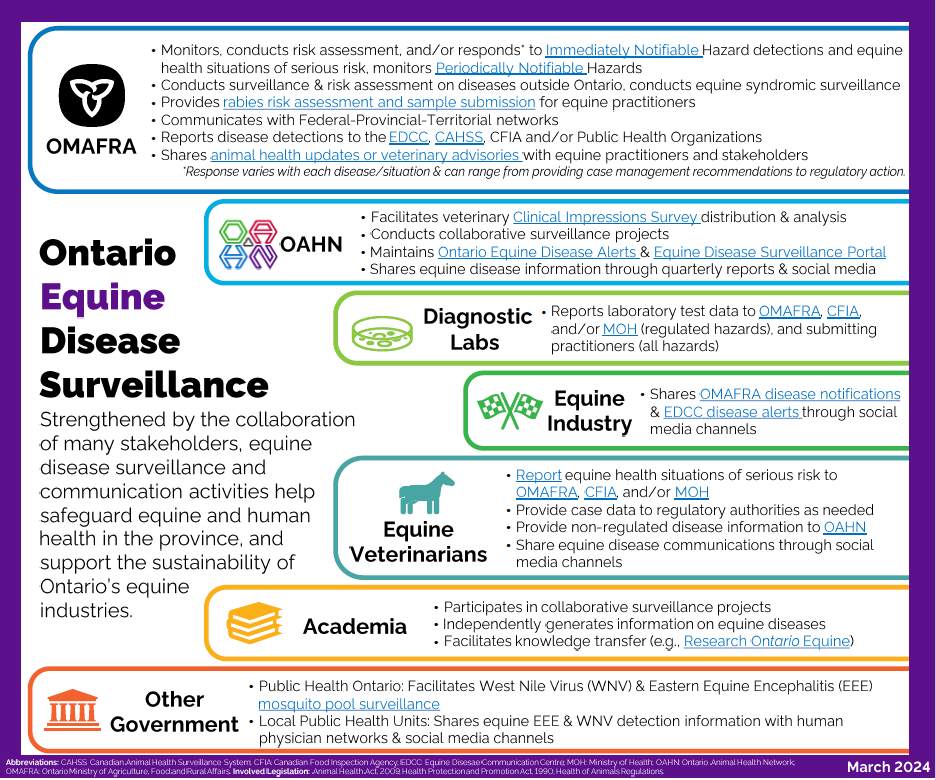
Equine disease surveillance in Ontario is a collaborative effort involving many public and private stakeholders. Diagnostic results generated by veterinary laboratories, clinical impression and case data provided by equine veterinarians, disease detections reported outside of Ontario by independent organizations, vector surveillance conducted by human health agencies, and research projects facilitated by Academic institutions or the Ontario Animal Health Network (OAHN), are all key sources of surveillance data. Strong communication between these stakeholders and with horse owners and caretakers supports both equine and human health in Ontario.
Please follow the links in the summary above for additional information on the associated activities or organizations and for many resources useful to equine industry members.
